
2. 造山带地质研究中心, 中国地质调查局西安地质调查中心, 西安 710054;
3. 中国科学技术大学地球和空间科学学院, 合肥 230026
2. Centre for Orogenic Belt Geology, Xi'an Center of Geological Survey, CGS, Xi'an 710054, China;
3. School of Earth and Space Sciences, University of Science and Technology of China, Hefei 230026, China
西昆仑-喀喇昆仑造山带位于青藏高原西北缘,是特提斯构造域重要组成部分(图 1a),主要包括铁克里克地块、西昆仑地块和甜水海地块三大构造单元(Molnar and Tapponnier, 1975; 任纪舜等, 1999; 姜春发等, 2000; 肖文交等, 2000; Xiao et al., 2002, 2005; 许志琴等, 2007; 李荣社等, 2011)。自新元古代晚期以来,该地区经历了特提斯洋盆的开启、俯冲、增生以及微陆块多次增生造山,发生多期构造、岩浆及成矿作用,这一复杂的构造演化过程和特殊的大地构造位置让其成为研究青藏高原周缘造山带及早期演化的热点地区之一,也是研究特提斯洋构造演化的关键部位,长期以来备受中外学者关注(Mattern et al., 1996; Jiang et al., 2002; Wang, 2004; 肖序常和王军, 2004; 张传林等, 2007; Ji et al., 2011; Pan et al., 2012; Liu et al., 2014; 何世平等, 2014; Wang et al., 2015; Zhang et al., 2016, 2018a, b, 2019;许志琴等, 2016; 张辉善等, 2016; 李三忠等, 2017;胡军等, 2017; 计文化等, 2018)。

|
图 1 西昆仑地质构造略图及早古生代年代学统计(据李荣社等, 2008; Wang et al., 2013; 张辉善等, 2016修改) TKT-铁克里克地块;WKT-西昆仑地块;TST-甜水海地块;OKS-奥依塔格-柯岗缝合带;MKS-麻扎-康西瓦缝合带;HQS-洪山湖-乔尔天山缝合带;KKF-喀喇昆仑断裂.黑色字体为侵入岩年龄,红色字体为火山岩年龄 Fig. 1 Simplified geological map of the Western Kunlun Orogenic Belt (modified after Li et al., 2008; Wang et al., 2013; Zhang et al., 2016) TKT-Tiekelike Terrane; WKT-Tiekelike Terrane; TST-Tiekelike Terrane; OKS-Oytag-Kegang Suture; MKS-Mazha-Kangxiwa Suture; HQS-Mazha-Kangxiwa Suture; KKF-Karakorum Fault. Black font represents the age of intrusive rock, red font stands for the age of volcanic rock |
甜水海地块作为西昆仑-喀喇昆仑造山带重要的组成部分,大地构造位置上夹持于麻扎-康西瓦板块缝合带和洪山湖-乔尔天山板块缝合带之间(图 1b)(Hsü, 1988; 潘裕生, 1990; Matte et al., 1996; Mattern and Schneider, 2000; 许志琴等, 2011)。近年来,有关其晚古生代-中生代构造演化过程已经日趋清晰(计文化, 2005; Jiang et al., 2012, 2013, 2014; 计文化等, 2014; Liu et al., 2015; 康磊等, 2015; 乔耿彪等, 2015a; Zhang et al., 2016; 查显锋等, 2018),但对其早古生代演化历史的认知程度仍然很低。长期以来,西昆仑-喀喇昆仑造山带内麻扎-康西瓦缝合带以南没有发现确切的寒武纪岩浆作用记录,已发现的寒武纪岩浆活动主要分布于铁克里克地块和西昆仑地块(图 1b)。近年来,甜水海地块地质调查研究表明,区域上发育一系列的寒武纪岩浆作用记录,如大量的花岗岩类、基性岩墙、双峰式火山岩等(陕西省地质调查院, 2011①; 燕长海等, 2012; 陕西省地质调查中心, 2012②, 2014③; 高晓峰等, 2013b;四川省核工业地质调查院, 2014④; 林尚康等, 2015; 乔耿彪等, 2015b; Hu et al., 2016; 朱杰等, 2016; 张辉善等, 2016; 胡军等, 2017)。这些岩浆活动为揭示西昆仑造山带构造演化历史提供了重要的地质信息,是目前探索西昆仑寒武纪构造演化的最好实物载体,然而,关于该期岩浆作用性质及构造背景存在较大的争议:(1)塔阿西一带发现早寒武世花岗岩类(图 1b,545~515Ma,陕西省地质调查院, 2011;陕西省地质调查中心, 2012, 2014; 朱杰等, 2016)形成于俯冲背景下岛弧环境,是幔源岩浆与壳源熔体混合而成的产物;(2)麻扎一带中晚寒武世花岗岩类(图 1b,514~498Ma,四川省核工业地质调查院, 2014; 张辉善等, 2016)形成于俯冲背景下岩浆弧构造环境,是地壳发生重熔,有幔源物质加入,并经历一定程度的分离结晶作用形成的结果;(3)赞坎铁矿一带发现早寒武世火山岩(图 1b, 544~521Ma, 陕西省地质调查中心, 2012, 2014; 高晓峰等, 2013b; 林尚康, 2015;乔耿彪等, 2015b)及基性岩墙(图 1b, 544~543Ma, 陕西省地质调查中心, 2012, 2014)形成于伸展构造背景下陆内裂谷环境,是早期俯冲洋/陆壳流体交代的亏损地幔减压部分熔融并经历一定程度分离结晶作用形成的产物;(4)同时,部分研究者根据地层、沉积特征推测寒武纪构造背景为被动陆缘构造环境(杨克明, 1994; 计文化, 2005; 李博秦, 2007; 计文化等, 2014; 柳坤峰等, 2014)。以上研究暗示:如果甜水海地块北缘该时期构造背景为被动大陆边缘,所代表的麻扎-康西瓦原特提斯洋存在向北俯冲的可能;如果甜水海地块北缘该时期构造背景为活动大陆边缘,所代表的麻扎-康西瓦原特提斯洋存在向南俯冲的可能。因此甜水海地块寒武纪构造背景需要进一步明确:究竟寒武纪经历了怎样的构造演化过程?到底有没有转化为活动大陆边缘?如果有,何时转化为活动大陆边缘?这些问题的解决对于探讨和认识西昆仑-喀喇昆仑地区早古生代地质演化具有重要的科学意义。
① 陕西省地质调查院. 2011.新疆塔什库尔干塔吉克自治县1:5万J43E017015等4幅区域地质调查报告
② 陕西省地质调查中心. 2012.新疆1:5万J43E016014等4幅区域地质调查报告
③ 陕西省地质调查中心. 2014.新疆1:5万J43E014012等7幅区域地质调查报告
④ 四川省核工业地质调查院. 2014.新疆叶城县麻扎-塔什库尔干县塔吐鲁沟一带1︰5万区域地质矿产调查报告
鉴于此,本文通过对甜水海地块中部麻扎地区新发现的寒武纪火山岩进行野外地质调查、岩相学、岩石地球化学和锆石U-Pb年代学研究,结合近年来在西昆仑地区新获得的大量精确同位素年代学数据进一步讨论该地块寒武纪的构造属性,为解决上述问题提供有利的证据。
1 区域地质背景西昆仑及邻区(图 1b)自北向南依次划分为铁克里克地块、西昆仑地块和甜水海地块等三大构造单元,其中铁克里克地块和西昆仑地块以奥依塔格-柯岗断裂为界,西昆仑地块和甜水海地块以麻扎-康西瓦断裂为界。
铁克里克地块被认为是塔里木陆块的褶皱基底,主要由前寒武纪地层组成,新的同位素年代学资料显示该地区的前寒武纪地层以新元古界为主(王超等, 2009; Wang et al., 2015)。岩浆活动规模较小,有少量元古宙和早古生代花岗岩出露(Ye et al., 2008; Wang et al., 2014; 康磊等, 2014)。
西昆仑地块发育前寒武纪、古生代、中生代地层,岩浆活动较为强烈,元古宙到中生代花岗岩、早古生代库地蛇绿混杂岩和蒙古包-普守蛇绿混杂岩(肖序常等, 2003; 张传林等, 2005; 王炬川等, 2006)均有出露,其中早古生代花岗岩分布较为广泛(袁超等, 1999; 崔建堂等, 2006a, b, 2007a, b; 张占武等, 2007; 于晓飞等, 2011; 王超等, 2013; 高晓峰等, 2013a),早中生代花岗岩次之,元古宙花岗岩发育规模最小。
甜水海地块也被称为喀喇昆仑增生楔(Hsü, 1988; Mattern et al., 1996; Mattern and Schneider, 2000)或者甜水海增生楔(Xiao et al., 2005),被认为是古特提斯洋盆从寒武纪-三叠纪向北俯冲形成的巨型俯冲增生杂岩带(Wang, 2004),而Ji et al.(2011)通过对该区发现的古元古代火山岩的研究认为存在前寒武纪基底,结合该地区地层结构、岩浆期次与西昆仑的显著差异,认为甜水海是一个微地块。该地块北部主要为一套二叠纪-三叠纪复理石沉积,南部主要出露元古宙和古生代地层,但均遭受了一定程度的变质变形作用。甜水海地块内前寒武地层主要为古元古界布伦阔勒岩群和长城纪-青白口纪地层,寒武纪地层出露较少,而最近的研究中从古元古界布伦阔勒岩群解体出寒武纪火山岩地层(张传林等, 2007; 陕西省地质调查中心, 2012; 燕长海等, 2012; 高晓峰等, 2013b; 谢从瑞等, 2013; 林尚康等, 2015; 乔耿彪等, 2015a, b);同时在麻扎地区也有存在寒武纪地层可能性(张辉善等,2016)。因此,甜水海地块元古代-早古生代早期(寒武纪)地层的归属和时限还需要进一步明确。该地块岩浆活动较为发育,其中主要发育早中生代花岗岩,沿麻扎-康西瓦断裂分布。近年来在该地块发现了少量新元古代-早古生代侵入岩和火山岩(图 1b,边小卫等, 2013; 高晓峰等, 2013b; 康磊等, 2014; 乔耿彪, 2015a; 林尚康等, 2015; Hu et al., 2016; Zhang et al., 2018a)。
2 野外地质和岩相学特征本次发现的寒武纪火山岩地层位于麻扎地区以东,呈北西向带状延伸(图 2),岩性主要以安山岩、英安岩、流纹岩、流纹质凝灰岩、英安质凝灰岩、英安质火山角砾岩为主(图 3、图 4a, b),出露少量的砂岩和粉砂质板岩,区域上该地层单元与前寒武地层(下寒武统-中元古界?)呈断层接触,上被石炭系砾岩不整合覆盖,区内寒武纪花岗岩出露,基性岩脉发育(图 3)。

|
图 2 甜水海麻扎地区寒武纪火山岩分布图(底图据四川省核工业地质局二八二大队,2015①) Fig. 2 Distribution of Cambrian volcanic rocks in Mazha area of Tianshuihai Terrane |
① 四川省核工业地质局二八二大队. 2015. 1:5万J43E022021等5幅区域地质调查报告

|
图 3 甜水海地块麻扎地区火山岩剖面图 Fig. 3 The geological sections of volcanic rocks in Mazha area of Tianshuihai Terrane |
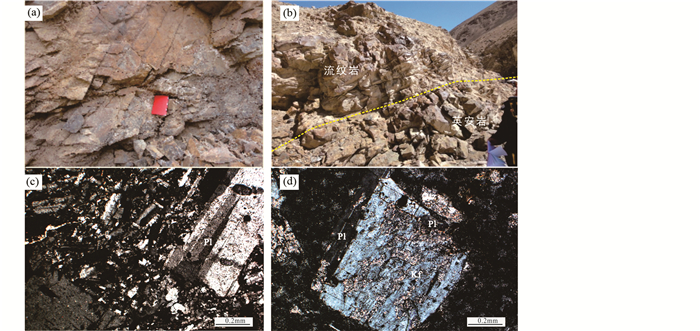
|
图 4 麻扎火山岩野外地质以及显微镜下特征 (a)安山岩露头;(b)英安岩与流纹岩岩性分界线;(c)安山岩镜下显微照片(+);(d)英安岩镜下显微照片(+).Pl-斜长石;Kf-钾长石 Fig. 4 Field geological and microphotographs showing features of volcanic rocks in Mazha area (a) andesite outcrop; (b) lithological boundary between dacite and rhyolite; (c)microscopic photograph of andesite(+); (d)microscopic photograph of dacite(+). Pl-plagioclase; Kf-K-feldspar |
安山岩(A34-1),岩石为深灰色,斑状结构、块状构造。斑晶由斜长石、暗色矿物假像组成,杂乱分布,部分略显定向排列,粒度0.25~3.5mm。斜长石呈半自形板状,高岭土化、绢云母化明显。暗色矿物已全部被绿泥石、碳酸盐交代呈假像。基质为交织结构,由斜长石、暗色矿物假像组成,其中斜长石呈微晶状,粒度0.05~0.25mm,杂乱分布(图 4c)。
英安岩(PM55-04),岩石为灰色、褐红色,斑状结构、块状构造,部分具有流纹构造。斑晶由钾长石、斜长石、石英、暗色矿物假像组成,杂乱分布,粒度0.2~4.3mm。基质具有霏细结构,由重结晶石英、斜长石、云母及隐晶质组成。见少量次生石英似堆状、似脉状不均匀分布(图 4d)。
流纹岩(PM55-06),岩石为浅灰白色、斑状结构、流纹构造。斑晶由斜长石、钾长石、石英、黑云母、角闪石假像组成,具有溶蚀港湾状不规则边缘,杂乱分布,粒度0.2~3mm。基质为霏细结构,球粒结构,由长英质组成,后期普遍发生重结晶作用,新生的细粒石英及鳞片状云母呈条带状,具有定向排列的特点。
3 分析方法主、微量元素在西南冶金地质测试所X荧光光谱(XRF)和等离子光谱质谱法(ICP-MS)测定,主量元素的分析测试误差小于1%,微量元素的分析测试误差在5%左右。
锆石样品是从英安岩(PM55-04、PM55-05)和流纹岩(PM55-06)通过人工重砂、电磁选和双目镜下挑选后,将结晶好、透明度好、无裂隙、无包体的颗粒,用环氧树脂固定并抛光至锆石颗粒完全暴露出,然后进行阴极发光(CL)内部结构及LA-MC-ICP-MS同位素分析测试。锆石U-Pb定年测试在中国地质科学院矿产资源研究所MC-ICP-MS实验室完成,锆石定年分析所用仪器为Finnigan Neptune型MC-ICP-MS及与之配套的Newwave UP 213激光剥蚀系统。激光剥蚀所用的斑束直径为25μm,频率为10Hz,能量密度约为2.5J/cm2,以He为载气。信号较小的207Pb、206Pb、204Pb(+ 204Hg)、202Hg用离子计数器接收,208Pb、232Th、238U信号用法拉第杯接收,实现了所有目标同位素信号的同时接收并且不同质量数的峰基本上都是平坦的,进而可以获得高精度的数据。均匀锆石颗粒207Pb/206Pb、206Pb/238U、207Pb/235U的测试精度(2σ)均为2%左右。LA-MC-ICP-MS激光剥蚀采样采用单点剥蚀的方式,数据分析前用锆石GJ-1进行调试仪器,使之达到最优状态。锆石U-Pb定年以锆石GJ-1为外标,U、Th含量以锆石M127为外标进行校正。测试过程中在每测定10个样品前后重复测定2个锆石GJ-1对样品进行校正,并测量1个锆石标样Plesovice,观察仪器的状态以保证测试的精确度。数据处理采用ICPMSDataCal 4.3程序(Liu et al., 2008)。测量过程中206Pb/204Pb>1000的分析结果未进行普通铅校正,而204Pb含量异常高的分析点可能受到包体等普通Pb的影响,在计算时剔除,锆石年龄谐和图用Isoplot 3.75程序获得(Ludwig, 2012)。详细实验测试流程参照侯可军等(2009)。
4 分析结果 4.1 测年结果 4.1.1 英安岩英安岩(PM55-04)样品中锆石粒径长约70~160μm、宽约50~120μm,以自形柱状晶形为主,在阴极发光图像中(图 5a),锆石具有典型振荡韵律环带结构,部分锆石内部可见继承核,Th/U比值为0.46~2.52(表 1),具有岩浆锆石的特点。选取了16颗锆石进行LA-ICP-MS U-Pb年龄测试(表 1),8个点的206Pb/238U的年龄值介于508±3Ma~518±3Ma,加权平均结果为513.0±2.7Ma(n=8,MSWD=1.02)(图 6a),该年龄代表了安山岩形成的年代;值得注意的是,该样品中有8个特殊点,其中4号和15号测点被舍弃的原因为测试误差过大(206Pb/238U年龄相对标准偏差分别为4.4%和12.6%);7、10、11、14和16号点被舍弃的原因为普通铅过高,且经历铅丢失,导致数据谐和度过低(53%~84%),年龄结果不具参考价值;另外获得了一颗锆石(5号点)206Pb/238U年龄为900.0±7.1Ma,可能是由于测试时打到继承锆石之上,故其年龄较老,该数据代表从围岩捕获的继承锆石年龄(图 5a)。
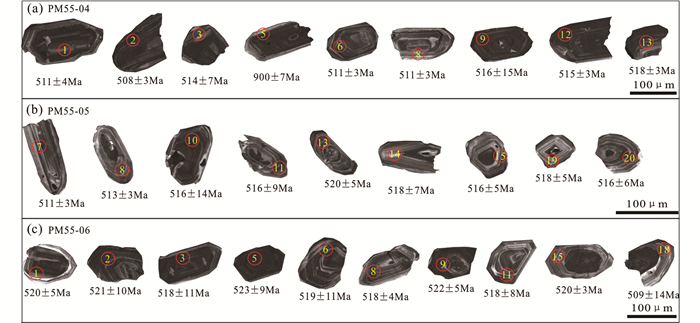
|
图 5 麻扎地区中酸性火山岩锆石CL图像 Fig. 5 Zircon CL images of intermediate-felsic volcanic rocks in Mazha area |
|
|
表 1 甜水海地块麻扎地区火山岩锆石U-Pb同位素测定结果 Table 1 Zircon U-Pb isotopic results of volcanic rocks in Mazha area of Tianshuihai Massif |
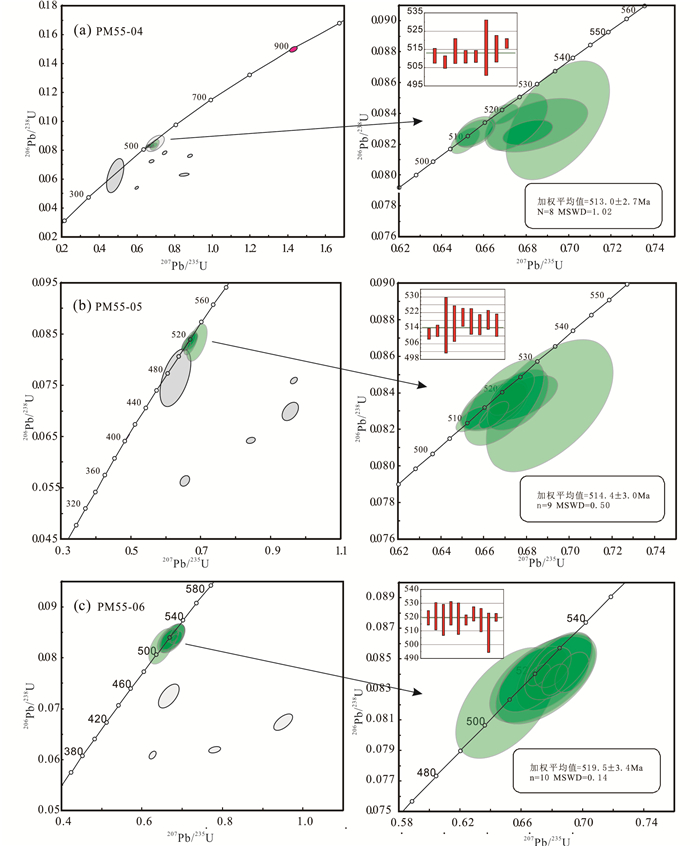
|
图 6 麻扎地区中酸性火山岩锆石U-Pb谐和图 Fig. 6 U-Pb concordia diagrams of intermediate-felsic volcanic rocks in Mazha area |
英安岩(PM55-05)样品中锆石粒径长约30~150μm,以自形粒状晶形为主,少数呈柱状,在阴极发光图像中(图 5b),锆石具有典型振荡韵律环带结构,Th/U比值为0.84~1.94(表 1),具有岩浆锆石的特点。选取了14颗锆石进行LA-ICP-MS U-Pb年龄测试(表 1),9个点的206Pb/238U的年龄值介于511±3Ma~520±5Ma,加权平均结果为514.4±3.0Ma(n=9,MSWD=0.5),该年龄代表了英安岩形成的年代;该样品中有5个特殊点,其中16号点被舍弃的原因为误差太大(206Pb/238U年龄相对标准偏差达4.8%);1、5、6和17号点被舍弃的原因为存在过多普通铅且发生铅丢失,导致数据谐和度过低(55%~63%),年龄不具参考价值。
4.1.2 流纹岩流纹岩(PM55-06)样品中锆石粒径长约60~170μm、宽约30~60μm,以自形柱状晶形为主,少数呈粒状,在阴极发光图像中(图 5c),锆石具有典型振荡韵律环带结构,Th/U比值为0.52~1.57(表 1),具有岩浆锆石的特点,选取了14颗锆石进行LA-ICP-MS U-Pb年龄测试(表 1),10个点的206Pb/238 U的年龄值介于509±14Ma~523±9Ma,加权平均结果为519.5±3.4Ma(n=10,MSWD=0.14),该年龄代表了流纹岩形成的年代(图 6c);该样品中也有4个特殊点,4、12、14和16号点被舍弃的原因为存在过多普通铅且发生铅丢失,导致数据谐和度过低(52%~85%),年龄不具参考价值。
4.2 岩石地球化学特征10件火山岩样品的主量和微量元素分析结果见表 2,其中PM34和PM55分别代表从实测剖面上采集的安山岩和英安岩。野外和镜下观察显示,10件火山岩样品均发生了不同程度的热液蚀变,测试数据的烧失量较大(2.28%~8.44%),这将干扰活动性元素(如Ba、K、Na、Rb、Sr、U)的含量(Deng et al., 2015, 2016, 2017)。本次主要采用受蚀变作用影响较小的高场强元素(Nb、Ta、Zr、Hf、Ti、P等)、相容元素(Cr、Ni)和稀土元素(REE)等,讨论和判别蚀变岩石的类型和成因。
|
|
表 2 麻扎地区火山岩主量元素(wt%)与微量元素(×10-6)化学组成 Table 2 Major (wt%) and trace (×10-6) elements compositions of the volcanic rocks in the Mazha area |
将蚀变岩石的烧失量扣除,重新100%标准化后显示,5件安山岩的SiO2含量在57.0%~67.2%之间,平均值为63.1%;Al2O3含量在13.7%~17.3%之间,平均值为15.5%;MgO含量在1.91%~7.17%之间,平均值为4.29%;Mg#在39.1~65.3之间,平均值为55.0;FeOT/MgO比值在1.12~3.26之间;K2O含量在1.12%~5.52%之间,平均值为2.40 %(表 2、图 7)。除1件样品(PM34-12)投入粗安岩区域,其余4件样品均投入安山岩区域(图 8a);在Co-Th图解中,3件样品投入了钙碱性系列区域,2件样品投入了高钾钙碱性系列和橄榄粗玄岩系列区域(图 8b)。5件英安岩的SiO2含量在63.8%~71.8%之间,平均值为67.5%;Al2O3含量在13.4%~15.4%之间,平均值为14.4%;MgO含量在0.28%~1.19%之间,平均值为0.77%;Mg#在9.98~36.5之间,平均值为25.1;FeOT/MgO比值在3.64~18.9之间;K2O含量为4.84%~9.27%,Na2O含量为0. 13%~1.45%,显示高钾低钠特征(表 2、图 7)。5件英安岩样品均投入流纹英安岩/英安岩区域(图 8a);在Co-Th图解中,1件样品投入了钙碱性系列区域,4件样品投入了高钾钙碱性系列和橄榄粗玄岩系列区域(图 8b)。
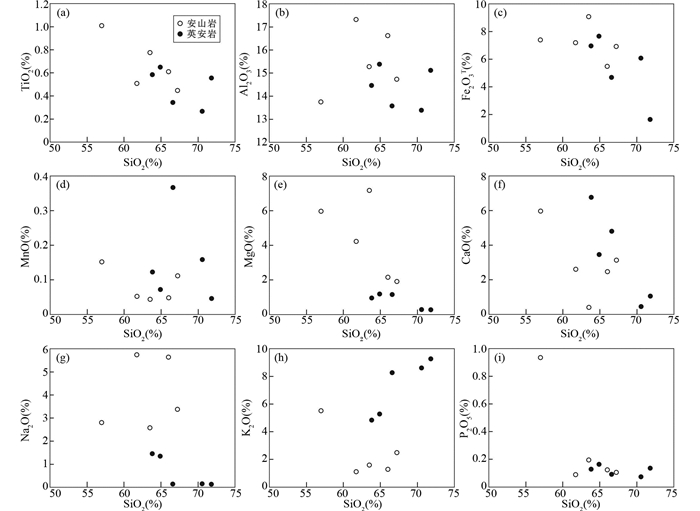
|
图 7 麻扎地区火山岩Harker图解 Fig. 7 Harker diagrams of the volcanic rocks in Mazha area |

|
图 8 麻扎地区安山岩和英安岩岩石类型和系列划分 (a)Zr/TiO2×0.0001-Nb/Y图解(据Winchester and Floyd, 1977);(b)Th-Co图解(据Hastie et al., 2007) Fig. 8 Diagrams of classification and rock series of the andesites and dacites in Mazha area (a) Zr/TiO2×0.0001 vs. Nb/Y diagram (after Winchester and Floyd, 1977); (b) Th vs. Co diagram (after Hastie et al., 2007) |
安山岩的∑REE在59.8×10-6~363×10-6之间,球粒陨石标准化的REE配分曲线呈现右倾,展示出轻稀土(LREE)相对富集,重稀土(HREE)相对平坦的特征(图 9a);除1件样品(PM34-12)的LREE相对于HREE明显富集外,其余4件样品的(La/Sm)N和(La/Yb)N范围变化相对较小,分别为2.73~3.72和4.73~9.06;δEu范围在0.59~1.27,表现为Eu的负异常到微弱的Eu的正异常。英安岩的REE特征与安山岩具有一定相似性。英安岩的∑REE在73.2×10-6~127×10-6之间,球粒陨石标准化的REE配分曲线呈现右倾,展示出轻稀土(LREE)相对富集,重稀土(HREE)相对平坦的特征(图 9c);5件样品的(La/Sm)N和(La/Yb)N范围变化相对较小,分别为2.63~4.69和2.94~10.90;δEu范围在1.04~1.61,表现为Eu的正异常。在原始地幔标准化图解中,安山岩和英安岩呈现出相似的特征,即Rb、Ba、Th、U、K相对富集,高场强元素Nb、Ta、Ti相对亏损,具有岛弧岩石的特征(图 9b, d)。
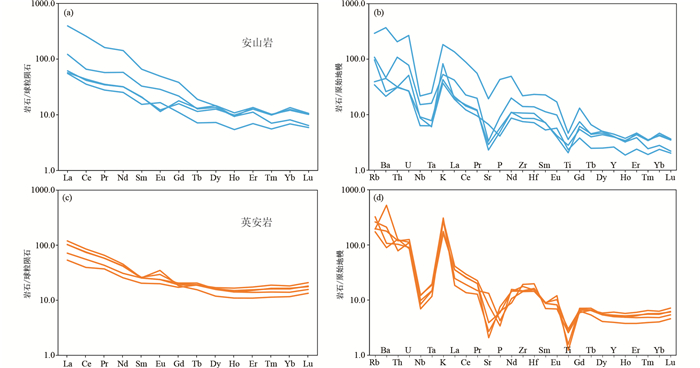
|
图 9 麻扎地区火山岩球粒陨石标准化稀土元素配分图(a)和原始地幔标准化微量元素蛛网图(b)(标准化值据Sun and McDonough, 1989) Fig. 9 Chondrite-normalized REE patterns (a) and primitive mantle-normalized trace elements pattern (b) of the volcanic rocks in Mazha area (normalized data after Sun and McDonough, 1989) |
麻扎地区发现这套火山岩-沉积岩,主要由安山岩、英安岩、流纹岩及其火山碎屑岩和少量沉积岩组成(图 3),安山岩、英安岩和流纹岩呈互层状产出,本次测得英安岩和流纹岩锆石U-Pb年龄为519~513Ma(图 5),认为可代表火山岩喷发的时代,表明这套火山-沉积地层形成于中寒武世。
甜水海地块寒武纪地层出露较少,主要分布在西部以及中部,近年来在西部塔阿西-赞坎铁矿一带,从古元古界布伦阔勒岩群解体出一套新元古代-早古生代早期绿片岩相区域变质岩(含铁岩系建造);其中发育早寒武世(544~521Ma)火山-沉积岩系,主要为绿片岩相(含铁岩系建造),局部角闪岩相,变形强烈,出露岩性主要为中基性火山岩、少量酸性火山岩和沉积岩(张传林等, 2007; 陕西省地质调查中心, 2012; 燕长海等, 2012; 高晓峰等, 2013b; 谢从瑞等, 2013; 林尚康等, 2015; 乔耿彪等, 2015a, b);而最近的研究中在麻扎地区识别出一套中元古代-早古生代早期低绿片岩相的浅变质岩(张辉善等, 2016),该套岩石向东延伸,在研究区出露,与这套寒武纪火山-沉积岩呈断层接触,主要为灰色弱变形石英绢云千枚岩、片理化粉砂质板岩、变质砂岩、碳泥质砂板岩以及少量片岩,未见火山岩出露。而本区岩性主要以中酸性火山岩夹少量碎屑岩为主,也是一套低绿片岩相的浅变质岩质。根据岩石组合类型、变质变形特征以及形成时代对比,该套火山-沉积岩与西部塔阿西一带早寒武世火山-沉积岩有显著差别,可能存在早寒武世(544~521Ma)和中寒武世(519~513Ma)两套火山岩;与区内新厘定的前寒武系地层对比,变质程度以及形成时代非常相似,但岩石组合具有差异,本区工作条件恶劣,未发现火山岩及相应的化石可供进一步对比,所以无法判断该地层的归属,因此将该套火山-沉积地层单独划分。
5.2 安山岩和英安岩的成因安山岩是一类广泛分布于活动大陆边缘和岛弧等地区的中性火山岩。部分安山岩由于具有相对较高的Mg#值或MgO含量(即“高镁”特征)而被称为高镁安山岩。相比于普通的岛弧安山岩,高镁安山岩以MgO>5%、FeOT/MgO < 1.5、Al2O3 < 16%和CaO < 10%(Tatsumi, 2001)或Mg#值>45(Kelemen, 1995)为特征,同时具有较高的Cr、Ni含量。除主要分布于汇聚板块边缘外,高镁安山岩还少量分布于板块内部(Gao et al., 2004; Rao et al., 2006; Wang et al., 2009)。
2件安山岩样品(P34-5、P34-12)的地球化学特征符合Tatsumi(2001)和Kelemen(1995)所定义的高镁安山岩;同时这2件样品属于低Fe钙碱性系列,在SiO2-MgO图中落到了高镁安山岩区域,具有高镁安山岩的典型特征(图 10)。其余3件安山岩样品(P34-1、P34-10、P34-11)的地球化学特征与Tatsumi(2001)和Kelemen(1995)所定义的高镁安山岩有一定差别,不是典型的高镁安山岩;不过这3件样品具也属于低Fe钙碱性系列-钙碱性系列,在SiO2-MgO图中落到了镁安山岩区域,具有镁安山岩的典型特征(图 10)。因此,5件安山岩样品应为镁安山岩-高镁安山岩,是富镁安山岩系列。

|
图 10 镁安山岩的SiO2-FeOT/MgO (a)图解和SiO2-MgO (b)图解(据邓晋福等, 2010, 2015) (a)直线为钙碱系列(CA)与拉斑系列(TH)分界线,点划线为低Fe钙碱系列(LF-CA)与中Fe钙碱系列的边界;(b)实线PQ和RS分别为HMA /MA与MA /非MA的边界 Fig. 10 SiO2 vs. FeOT/MgO (a) and SiO2 vs. MgO diagram (b) of magnesian andesite (after Deng et al., 2010, 2015) (a) the straight line is the CA /TH boundary, the dot line is the boundary between low Fe calc-alkaline series and medium Fe calc-alkaline series; (b) the lines PQ and RS mean the boundary of HMA /MA and MA /non-MA respectively |
5件镁安山岩-高镁安山岩(富镁安山岩系列)的MgO、Cr和Ni含量高(表 2),这暗示了一个偏基性的源区。关于富镁安山岩的形成,目前主要有以下几种机制:(1)基性岩浆与酸性岩浆的混合作用(Tatsumi et al., 2002; Kawabata and Shuto, 2005; Guo et al., 2007; Streck et al., 2007);(2)普通地幔橄榄岩的部分熔融(Falloon et al., 1997; Hirose, 1997);(3)俯冲的洋壳熔体在上升过程中与地幔橄榄岩反应(Kelemen, 1995; Rapp et al., 1999; Tatsumi, 2001; Tatsumi and Hanyu, 2003; Zhang et al., 2012);(4)拆沉的下地壳熔体与地幔橄榄岩反应(Kelemen et al., 1998; Xu et al., 2002; Gao et al., 2004);(5)富集的地幔楔部分熔融(Stern and Hanson, 1991; Smithies and Champion, 2000; 甘成势等, 2016)。
基性岩浆与酸性岩浆混合形成富镁安山岩需要在同一时期存在这两种岩浆(Tatsumi et al., 2002; Kawabata and Shuto, 2005; Guo et al., 2007; Streck et al., 2007),然而,在麻扎地区,岩性主要以安山岩、英安岩、流纹岩为主,未见大规模的基性岩浆岩出露,因此,麻扎地区的安山岩不太可能是岩浆混合成因。实验岩石学表明,对于普通的地幔橄榄岩,在贫水条件下熔融只会形成偏基性的玄武质熔体而非安山质熔体(Falloon et al., 1997)。在含水情况下,虽然地幔橄榄岩的固相线降低,地幔橄榄岩的熔融比例会提高,形成富镁的安山质熔体,然而这种富镁的熔体具有相对较高的Al2O3(17.2%~21.7%)和CaO(8.53%~9.99%)含量,较低的TiO2(0.55%~0.70%)、全铁(4.04%~5.36%)和Na2O(1.10%~3.09%)含量(Hirose, 1997)。本文5件安山岩样品的地球化学特征显然与之不符合(表 2),因此,普通的地幔橄榄岩在贫水或含水条件下熔融不会形成麻扎地区的安山岩。俯冲洋壳或拆沉下陆壳熔融形成的熔体与地幔橄榄岩反应,可以形成富镁的安山质岩岩浆,由此形成的富镁安山岩通常具有埃达克质岩石的特征,即高Sr、Sr/Y值、HREE亏损等特征(Rapp et al., 1999; Xu et al., 2002; Tatsumi and Hanyu, 2003; Gao et al., 2004; Kamei et al., 2004; Sun et al., 2012, 2017; Li et al., 2017; Zhang et al., 2017)。麻扎地区的安山岩样品在原始地幔标准化图解上呈现Sr的负异常、Sr/Y比值低(2.40~22.2之间,平均值为8.73)、REE配分模式显示HREE平坦而非亏损的特征(图 9a, b、表 2),这表明,俯冲洋壳或拆沉下地壳形成的熔体也不太可能是安山岩的源区。
普通的地幔橄榄岩熔融不能形成麻扎地区的富镁安山岩,不过如果地幔橄榄岩遭受改造(如俯冲板片流体、洋壳熔体或沉积物熔体的交代作用),则可以改变地幔橄榄岩的化学组成(Stern and Hanson, 1991;Smithies and Champion, 2000;甘成势等,2016);同时在大洋板片流体的交代下,不仅可以引入大量的大离子亲石元素,而且可以降低地幔橄榄岩的固相线,有助于部分熔融作用的发生。因此,麻扎安山岩可能的形成机制是:普通的地幔橄榄岩在俯冲板片流体、洋壳熔体或沉积物熔体的交代作用下形成的富集地幔楔,接着富集的地幔楔发生部分熔融形成安山质熔体。
由于麻扎地区的安山岩与英安岩在空间上相邻,呈互层产出;且二者都出露于中寒武系地层中。因此,不能将安山岩和英安岩的成因孤立对待。
在哈克图解中(图 7),5件富镁安山岩样品和5件英安岩样品的SiO2与其它主量元素的重量百分比相关性不显著,暗示在安山岩和英安岩的形成过程中,分离结晶所起的作用不明显(图 7);在用于判别部分熔融和分离结晶的La-La/Sm和La-La/Yb图解中,安山岩和英安岩的数据点主要落在了部分熔融的演化线上,表明部分熔融起主要作用,而分离结晶不明显(图 11a, b)。因此,在英安岩和富镁安山岩的形成过程中,源岩的部分熔融作用起主要作用,同时分离结晶作用有限。在MgO-Cr和MgO-Ni图解中,安山岩的MgO、Cr、Ni含量相对于英安岩明显较高,这可能暗示了安山岩源于基性源区相对较高比例的熔融,而英安岩则源于基性源区相对较低比例的熔融(图 11c, d)。
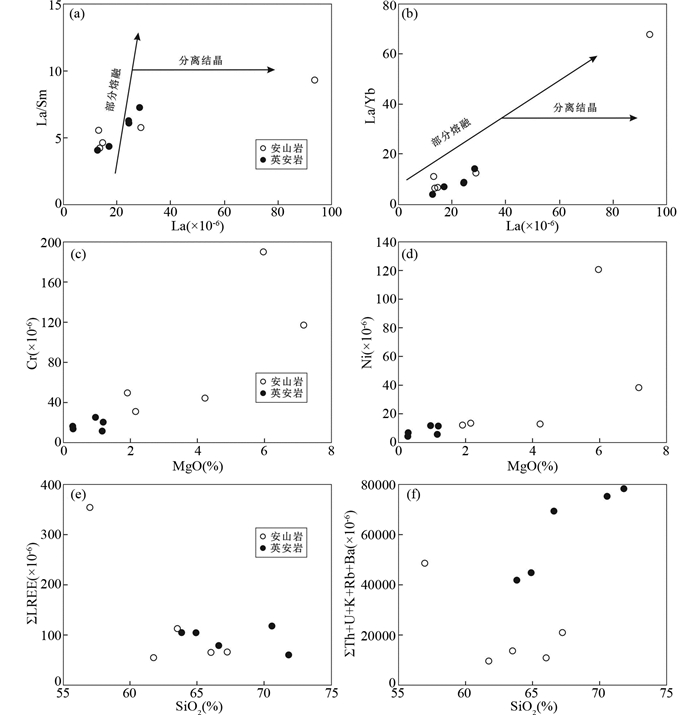
|
图 11 麻扎地区英安岩和安山岩主、微量元素图解 Fig. 11 Diagrams of major and trace elements of the andesites and dacites in Mazha area |
地壳相对地幔富集LREE和Rb、Ba、Th、U、K等元素,如图所示,在SiO2-∑LREE图解中,除了数据点PM34-12外,安山岩与英安岩的LREE含量没有差别(图 11e);但在SiO2-∑Rb+Ba+Th+U+K图解中,英安岩的Rb+Ba+Th+U+K相对于安山岩明显较高(图 11f);同时在SiO2-K2O图解中,英安岩的K2O含量(4.84%~9.27%之间,平均值为7.25%)也高于安山岩的K2O含量(1.12%~5.52%之间,平均值为2.40%)(图 7h)。另外,在Co-Th图解中,4件英安岩样品投到了高钾钙碱性系列和橄榄粗玄岩系列区域(图 8b),与之相比,仅2件安山岩样品投到了该区域(图 8b)。假定安山岩和英安岩遭受了相同的后期热液蚀变,那么它们Rb、Ba、Th、U、K等元素含量之间的差别除了源于后期的蚀变外,还可能源于岩浆混染了不同比例的地壳。当混染相对较少的地壳成分时,会形成Rb、Ba、Th、U、K等元素含量相对较低的安山岩;当混染相对较多的地壳成分时,会形成Rb、Ba、Th、U、K等元素含量相对较高的英安岩。
综上所述,麻扎地区的安山岩和英安岩可能源于富集地幔楔不同比例的部分熔融作用,所产生的岩浆在上升过程中又遭受了不同比例的地壳混染。富集地幔楔可能形成于大洋板片流体、沉积物熔体或洋壳熔体的交代作用,这可以改变地幔橄榄岩的化学组成,降低其固相线。当富集地幔楔发生相对高比例熔融时,会形成富Mg、Cr、Ni和SiO2低的岩浆,这样的岩浆粘度低,上升快,在地壳停留时间短,混染地壳的比例低,因此会形成具有相对低Rb、Ba、Th、U、K含量的富镁安山岩;与之相比,当地幔楔发生相对低比例的熔融时,会形成贫Mg、Cr、Ni和SiO2较高的岩浆,这样的岩浆粘度较大,上升缓慢,在地壳停留时间长,混染地壳的比例高,因此会形成Rb、Ba、Th、U、K含量相对高的英安岩。
5.3 构造环境前述研究显示,麻扎地区寒武纪中酸性火山岩以安山岩、英安岩和流纹岩为主, 在地球化学上属于钙碱性-橄榄粗玄岩系列。总体表现出右倾轻稀土富集分配模式和富集Rb、Ba、K、Th等大离子亲石元素,亏损Nb、Ta、Ti高场强元素,具有典型的陆缘弧岩浆岩特征(Atherton and Tarney, 1979)(类似于岛弧火山岩的地球化学特征)。同时中性火山岩主要为一套高镁质-镁质岩石组合,暗示其形成于俯冲消减环境岩浆弧构造环境(邓晋福, 2015)。另外从Th/Ta-Yb和Th/Yb-Ta/Yb图中可以看出(图 12a,b),样品均落在了活动大陆边缘区, 因此从岩石组合以及稀土、微量元素特征来看, 火山岩形成于活动大陆边缘(或陆缘弧)的大地构造环境,说明其成因很可能与特提斯麻扎-康西瓦洋向南俯冲有关。

|
图 12 甜水海地块麻扎地区火山岩Yb-Th/Ta图解(a)和Ta/Yb-Th/Yb图解(b)(底图据Gorton and Schandl, 2000) Fig. 12 Tectonic discrimination diagrams of Yb vs. Th/Ta (a) and Ta/Yb vs. Th/Yb (b) for the volcanic rocks in Mazha area of Tianshuihai Terrane (base map after Gorton and Schandl, 2000) |
近年来调查研究表明,在甜水海地块陆续发现了一系列的寒武纪岩浆作用记录,分布在西部塔阿西花岗岩、辉长岩和火山岩(图 1b,545~515Ma, 陕西省地质调查院, 2011;陕西省地质调查中心, 2012, 2014;高晓峰等, 2013b; 乔耿彪等, 2015b; 林尚康等, 2015; 朱杰等, 2016;Zhang et al., 2018a),中部麻扎花岗岩(图 1b,514~498Ma,四川省核工业地质调查院, 2014; 张辉善等, 2016)和东部大红柳滩花岗岩(图 1b,532~528Ma,Hu et al., 2016),说明甜水海地块北缘存在一条寒武纪的岩浆弧带,学者们认为与该时期原特提斯洋向南俯冲有关。另外在该地块已发现的孔兹岩(492~428Ma)、构造混杂岩带以及该带中发现的高压麻粒岩(456±30Ma),推测岩石发生变质与该时期特提斯洋俯冲、消减有关(杨坤光等, 2003; 许志琴等, 2004;王建平, 2008);上述变质和岩浆作用暗示甜水海地块北缘该时期构造背景为活动大陆边缘,所代表的麻扎-康西瓦原特提斯洋在寒武纪存在向南俯冲的可能。结合先前一直对该洋存在向北俯冲的认识(Wang, 2004; 王超等, 2013; 计文化等, 2014; 柳坤峰, 2014),根据西昆仑地块和甜水海地块早古生代岩浆、变质事件暗示麻扎-康西瓦原特提斯洋在寒武纪可能发生了双向俯冲。
那么甜水海地块在寒武纪何时转化为活动大陆边缘,目前对原特提斯洋裂解-消减构造转换时限认知程度非常有限。Zhang et al.(2018a)通过甜水海地块辉长岩研究,认为原特提斯洋向南开始发生消减的时间从~530Ma开始。而本次工作初步认为甜水海地块存在早寒武世(图 1b,火山岩544~521Ma,侵入岩545~515Ma)和中晚寒武世(火山岩519~513Ma,本文数据,侵入岩514~498Ma)两期火山岩浆事件;在塔阿西赞坎铁矿一带发现早寒武世双峰式火山岩及基性岩墙(陕西生地质调查中心, 2012, 2014; 高晓峰等, 2013b)形成于伸展构造背景下边缘裂谷环境,麻扎一带发现中晚寒武世高镁-镁安山岩以及花岗岩类形成俯冲背景岛弧构造环境,另外在西昆仑地块同期形成的库地花岗岩(507~500Ma)和蛇绿岩(525~494Ma)也形成与俯冲背景的岛弧或弧后盆地构造环境(图 13)(崔建堂等,2007a;王超等,2013;李天福等,2014)。因此,推测在早寒武纪末期(~ 520 Ma)原特提斯洋发生双向俯冲,甜水海地块北缘转化为活动大陆边缘(图 13)。
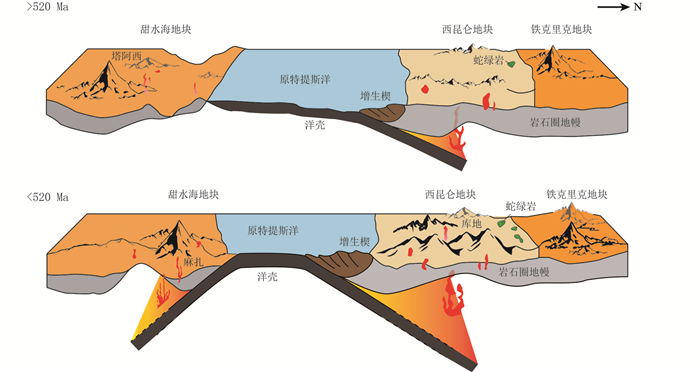
|
图 13 西昆仑-喀喇昆仑造山带寒武纪构造演化模式图(据张辉善等,2016修改) Fig. 13 Tectonic evolution model of the West Kunlun-Karakoram Orogenic Belt in Cambrian (modified after Zhang et al., 2016) |
(1) 甜水海地块麻扎地区新发现并厘定一套火山岩-沉积岩组合,主要由安山岩、英安岩、流纹岩及其火山碎屑岩和少量沉积岩组成。与安山岩互层产出的英安岩和流纹岩锆石U-Pb年龄介于519~513Ma之间,代表火山岩喷发的时代,表明这套火山-沉积地层形成于中寒武世。
(2) 麻扎安山岩具有高MgO含量和Mg#值,低FeOT/MgO比值,低Al2O3和CaO含量的特征,属于低铁钙碱系列高镁安山岩-镁安山岩,英安岩具有高硅、高钾、低镁、低钠的特征,属于高钾钙碱性系列。安山岩和英安岩总体表现出右倾轻稀土富集分配模式,富集Rb、Ba、K、Th等大离子亲石元素,亏损Nb、Ta、Ti高场强元素,具有典型的弧岩浆岩特征。
(3) 野外调查表明,安山岩与英安岩在空间上相邻,呈互层产出,且二者都出露于中寒武系地层中,暗示了二者在成因上紧密相联。岩石地球化学特征指示了安山岩和英安岩可能源于富集地幔楔不同比例的部分熔融作用,所产生的岩浆在上升过程中又遭受了不同比例的地壳混染。
(4) 麻扎地区寒武纪火山岩形成于原特提斯洋向南俯冲消减机制下的岛弧构造环境,结合区域资料,甜水海地块北缘存在一条寒武纪的岩浆弧带,可能存在两期岩浆作用,在早寒武系末期(~520Ma)原特提斯洋发生双向俯冲,甜水海地块北缘转化为活动大陆边缘。
致谢 成都理工大学刘顺教授、侯明才教授,贵州大学王约教授在野外提供了悉心指导;四川省核工业地质局二八二大队1:5万区调项目组康孔跃、张杰、史俊波、杨伟、汤鸿伟、陈备战、陈琳、祝大伟、宁秋林、李承栋、李同选等高级工程师,他们与作者一起在艰苦的西昆仑地区并肩作战、克服种种困难,获得了宝贵、翔实的第一手野外资料;中国地质科学院矿产资源研究所侯可军博士和中国地质大学(北京)原垭斌硕士在实验测试过程中给予了热情帮助;西北大学王超研究员,云南大学周家喜研究员,西安地质调查中心何世平研究员、陈守建研究员、张汉文研究员和李艳广工程师在论文写作过程中给予了精心指导;在此一并表示谢意!
Atherton M P and Tarney J. 1979. Origin of Granite Batholiths: Geochemical Evidence. Nantwich: Shiva, 1-148
|
Bian XW, Zhu HP, Ji WH, Cui JG, Luo QZ, Ren JG and Peng XP. 2013. The discovery of Qingbaikouan plutonite in Taxorgan, Xinjiang, and evidence from zircon LA-ICP-MS U-Pb dating of intrusive rock. Northwestern Geology, 46(1): 22-31 (in Chinese with English abstract) |
Cui JT, Wang JC, Bian XW, Zhu HP and Yang KJ. 2006a. Geological characteristics of Early Paleozoic amphibolite and tonalite in northern Kangxiwar, West Kunlun, China and their zircon SHRIMP U-Pb dating. Geological Bulletin of China, 25(12): 1441-1449 (in Chinese with English abstract) |
Cui JT, Wang JC, Bian XW and Zhu HP. 2006b. Geological characteristics of Early Paleozoic quartz diorite in the vicinity of Kangxiwar, West Kunlun, China and its zircon SHRIMP U-Pb dating. Geological Bulletin of China, 25(12): 1450-1457 (in Chinese with English abstract) |
Cui JT, Wang JC, Bian XW, Luo QZ, Zhu HP, Wang MC and Chen GC. 2007a. Zircon SHRIMP U-Pb dating of the Dongbake gneissic tonalite in northern Kangxiwar, West Kunlun. Geological Bulletin of China, 26(6): 726-729 (in Chinese with English abstract) |
Cui JT, Wang JC, Bian XW, Zhu HP, Luo QZ, Yang KJ and Wang MC. 2007b. Zircon SHRIMP U-Pb dating of Early Paleozoic granite in the Menggubao-Pushou area on the northern side of Kangxiwar, West Kunlun. Geological Bulletin of China, 26(6): 710-719 (in Chinese with English abstract) |
Deng JF, Liu C, Feng YF, Xiao QH, Su SG, Zhao GC, Kong WQ and Cao WY. 2010. High magnesian andesitic/dioritic rocks (HMA) and magnesian andesitic/dioritic rocks (MA):Two igneous rock types related to oceanic subduction. Geology in China, 37(4): 1112-1118 (in Chinese with English abstract) |
Deng JF, Feng YF, Di YJ, Liu C, Xiao QH, Su SG, Zhao GC, Meng F, Ma S and Yao T. 2015. Magmatic arc and ocean-continent transition:Discussion. Geological Review, 61(3): 473-484 (in Chinese with English abstract) |
Deng JH, Yang XY, Zhang ZF and Santosh M. 2015. Early Cretaceous arc volcanic suite in Cebu Island, Central Philippines and its implications on paleo-Pacific plate subduction:Constraints from geochemistry, zircon U-Pb geochronology and Lu-Hf isotopes. Lithos, 230: 166-179 DOI:10.1016/j.lithos.2015.05.020 |
Deng JH, Yang XY, Li S, Gu HL, Mastoi AS and Sun WD. 2016. Partial melting of subducted paleo-Pacific plate during the Early Cretaceous:Constraint from adakitic rocks in the Shaxi porphyry Cu-Au deposit, Lower Yangtze River Belt. Lithos, 262: 651-667 DOI:10.1016/j.lithos.2016.07.039 |
Deng JH, Yang XY, Qi HS, Zhang ZF, Mastoi AS and Sun WD. 2017. Early Cretaceous high-Mg adakites associated with Cu-Au mineralization in the Cebu Island, central Philippines:Implication for partial melting of the Paleo-Pacific plate. Ore Geology Reviews, 88: 251-269 DOI:10.1016/j.oregeorev.2017.05.006 |
Falloon TJ, Green DH, O'Neill HS and Hibberson WO. 1997. Experimental tests of low degree peridotite partial melt compositions:Implications for the nature of anhydrous near-solidus peridotite melts at 1GPa. Earth and Planetary Science Letters, 152(1-4): 149-162 DOI:10.1016/S0012-821X(97)00155-6 |
Gan CS, Wang YJ, Zhang YZ, Liu HC and Zhang LM. 2016. The identification and implications of the Late Jurassic shoshonitic high-Mg andesite from the Youjiang basin. Acta Petrologica Sinica, 32(11): 3281-3294 (in Chinese with English abstract) |
Gao S, Rudnick RL, Yuan HL, Liu XM, Liu YS, Xu WL, Ling WL, Ayers J, Wang XC and Wang QH. 2004. Recycling lower continental crust in the North China Craton. Nature, 432(7019): 892-897 DOI:10.1038/nature03162 |
Gao XF, Xiao PX, Kang L, Xi RG, Guo L, Xie CR and Yang ZC. 2013a. Origin of Datongxi pluton in the West Kunlun orogen:Constraints from mineralogy, elemental geochemistry and zircon U-Pb age. Acta Petrologica Sinica, 29(9): 3065-3079 (in Chinese with English abstract) |
Gao XF, Xiao PX, Kang L, Zhu HP, Guo L, Xi RG and Dong ZC. 2013b. Origin of the volcanic rocks from the Ta'Axi region, Taxkorgan Xinjiang and its geological significance. Earth Science (Journal of China University of Geosciences), 38(6): 1169-1182 (in Chinese with English abstract) DOI:10.3799/dqkx.2013.116 |
Gorton MP and Schandl ES. 2000. From continents to island arcs:A geochemical index of tectonic setting for arc-related and within-plate felsic to intermediate volcanic rocks. The Canadian Mineralogist, 38(5): 1065-1073 DOI:10.2113/gscanmin.38.5.1065 |
Guo F, Nakamuru E, Fan WM, Kobayoshi K and Li CW. 2007. Generation of palaeocene adakitic andesites by magma mixing, Yanji area, NE China. Journal of Petrology, 48(4): 661-692 DOI:10.1093/petrology/egl077 |
Hastie AR, Kerr AC, Pearce JA and Mitchell SF. 2007. Classification of altered volcanic island arc rocks using immobile trace elements:Development of the Th-Co discrimination diagram. Journal of Petrology, 48(12): 2341-2357 DOI:10.1093/petrology/egm062 |
He SP, Li RS, Wang C, Liu L and Shi C. 2014. Precambrian Geology of the Qinghai-Tibet Plateau and Its Adjacent Areas. Beijing: China University of Geosciences Press, 1-154 (in Chinese)
|
Hirose K. 1997. Melting experiments on lherzolite KLB-1 under hydrous conditions and generation of high-magnesian andesitic melts. Geology, 25(1): 42-44 DOI:10.1130/0091-7613(1997)025<0042:MEOLKU>2.3.CO;2 |
Hou KJ, Li YH and Tian YR. 2009. In situ U-Pb zircon dating using laser ablation-multi ion counting-ICP-MS. Mineral Deposits, 28(4): 481-492 (in Chinese with English abstract) |
Hsü KJ. 1988. Relict back-arc basins: Principles of recognition and possible new examples from China. In: Kleinspehn KL and Paola C (eds.). New Perspectives in Basin Analysis. New York: Springer, 245-263
|
Hu J, Wang H, Huang CY, Tong LX, Mu SL and Qiu ZW. 2016. Geological characteristics and age of the Dahongliutan Fe-ore deposit in the Western Kunlun orogenic belt, Xinjiang, northwestern China. Journal of Asian Earth Sciences, 116: 1-25 DOI:10.1016/j.jseaes.2015.08.014 |
Hu J, Wang H, Mu SL, Wang M and Hou XW. 2017. Geochemistry and Hf isotopic compositions of Early Paleozoic granites in Nanpingxueshan from the Tianshuihai Terrane, West Kunlun:Crust-mantle magmatism. Acta Geologica Sinica, 91(6): 1192-1207 (in Chinese with English abstract) |
Ji WH. 2005. The Late Paleozoic-Early Mesozoic tectonic frame in the western Kunlun-Karakorum area. Ph. D. Dissertation. Beijing: China University of Geosciences (Beijing) (in Chinese with English abstract)
|
Ji WH, Li RS, Chen SJ, He SP, Zhao ZM, Bian XW, Zhu HP, Cui JG and Ren JG. 2011. The discovery of Palaeoproterozoic volcanic rocks in the Bulunkuoler Group from the Tianshuihai Massif in Xinjiang of Northwest China and its geological significance. Science China (Earth Sciences), 54(1): 61-72 DOI:10.1007/s11430-010-4043-7 |
Ji WH, Chen SJ, Li RS and Wang XL. 2014. Characteristics of Paleozoic Tectonics and Evolution of Lithofacies and Palaeogeography of the Qinghai-Tibet Plateau and its Adjacent Areas. Wuhan: China University of Geosciences Press, 1-381 (in Chinese)
|
Ji WH, Chen SJ, Li RS, He SP, Zhao ZM and Pan XP. 2018. The origin of Carboniferous-Permian magmatic rocks in Oytag area, West Kunlun:Back-arc basin?. Acta Petrologica Sinica, 34(8): 2393-2409 (in Chinese with English abstract) |
Jiang CF, Wang ZQ and Li JT. 2000. Opening-Closing Tectonics of Central Orogen. Beijing: Geological Publishing House, 1-154 (in Chinese)
|
Jiang YH, Jiang SY, Ling HF, Zhou XR, Rui XJ and Yang WZ. 2002. Petrology and geochemistry of shoshonitic plutons from the western Kunlun orogenic belt, Xinjiang, northwestern China:Implications for granitoid geneses. Lithos, 63(3-4): 165-187 DOI:10.1016/S0024-4937(02)00140-8 |
Jiang YH, Liu Z, Jia RY, Liao SY, Zhou Q and Zhao P. 2012. Miocene potassic granite-syenite association in western Tibetan Plateau:Implications for shoshonitic and high Ba-Sr granite genesis. Lithos, 134-135: 146-162 DOI:10.1016/j.lithos.2011.12.012 |
Jiang YH, Jia RY, Liu Z, Liao SY, Zhao P and Zhou Q. 2013. Origin of Middle Triassic high-K calc-alkaline granitoids and their potassic microgranular enclaves from the western Kunlun orogen, Northwest China:A record of the closure of Paleo-Tethys. Lithos, 156-159: 13-30 DOI:10.1016/j.lithos.2012.10.004 |
Jiang YH, Liu Z, Jia RY, Liao SY, Zhao P and Zhou Q. 2014. Origin of early cretaceous high-K calc-alkaline granitoids, western Tibet:Implications for the evolution of the Tethys in NW China. International Geology Review, 56(1): 88-103 DOI:10.1080/01431161.2013.819963 |
Kamei A, Owada M, Nagao T and Shiraki K. 2004. High-Mg diorites derived from sanukitic HMA magmas, Kyushu Island, Southwest Japan arc:Evidence from clinopyroxene and whole rock compositions. Lithos, 75(3-4): 359-371 DOI:10.1016/j.lithos.2004.03.006 |
Kang L, Xiao PX, Gao XF, Xi RG, Yang ZC, Guo L and Dong ZC. 2014. Proterozoic intrusive magmatism in West Kunlun area and its inspiration to tectonic-magmatic evolution. Northwestern Geology, 47(4): 1-12 (in Chinese with English abstract) |
Kang L, Xiao PX, Gao XF, Xi RG and Yang ZC. 2015. Neopaleozoic and Mesozoic granitoid magmatism and tectonic evolution of the western West Kunlun Mountains. Geology in China, 42(3): 533-552 (in Chinese with English abstract) |
Kawabata H and Shuto K. 2005. Magma mixing recorded in intermediate rocks associated with high-Mg andesites from the Setouchi volcanic belt, Japan:Implications for Archean TTG formation. Journal of Volcanology and Geothermal Research, 140(4): 241-271 DOI:10.1016/j.jvolgeores.2004.08.013 |
Kelemen PB. 1995. Genesis of high Mg# andesites and the continental crust. Contributions to Mineralogy and Petrology, 120(1): 1-19 DOI:10.1007/BF00311004 |
Kelemen PB, Hart SR and Bernstein S. 1998. Silica enrichment in the continental upper mantle via melt/rock reaction. Earth and Planetary Science Letters, 164(1-2): 387-406 DOI:10.1016/S0012-821X(98)00233-7 |
Li BQ. 2007. Discussing the evolutive process of the Mazha-Kangxiwa-Subashi suture zone in West Kunlun orogen by stratigraphical way. Ph. D. Dissertation. Beijing: Chinese Academy of Geological Sciences (in Chinese with English abstract)
|
Li CY, Hao XL, Liu JQ, Ling MX, Ding X, Zhang H and Sun WD. 2017. The formation of Luoboling porphyry Cu-Mo deposit:Constraints from zircon and apatite. Lithos, 272-273: 291-300 DOI:10.1016/j.lithos.2016.12.003 |
Li RS, Ji WH and Yang YC. 2008. Kunlun Mountain and Its Adjacent Area Geology. Beijing: Geological Publishing House, 1-400 (in Chinese)
|
Li RS, Ji WH, He SP, Liu Y and Zhang HD. 2011. The two tectonic domain division discussion between the ancient Asian and Tethys in western China. Xinjiang Geology, 29(3): 247-250 (in Chinese with English abstract) |
Li SZ, Li T, Zhao SJ, Li XY, Liu X, Guo LL, Yu SY and Li SJ. 2017. Proto-Tethys Ocean in East Asia (Ⅳ):Deformation and evolution of microcontinents in the west segment of the northern Proto-Tethys Tectonic Domain. Acta Petrologica Sinica, 33(6): 1615-1632 (in Chinese with English abstract) |
Li TF and Zhang JX. 2014. Zircon LA-ICP-MS U-Pb ages of websterite and basalt in Kudi ophiolite and the implication, West Kunlun. Acta Petrologica Sinica, 30(8): 2393-2401 (in Chinese with English abstract) |
Lin SK, Tang HS and Ren T. 2015. In-situ U-Pb ages and Hf isotopic analyses of zircons from rhyodacite in Zankan, West Kunlun area. Henan Science, 33(6): 986-992 (in Chinese with English abstract) |
Liu KF, Wang YH, Jiang GL, Zhang SM and Zhang KX. 2014. Evolution of Neoproterozoic-Mesozoic sedimentary basins of West Kunlun area. Earth Science (Journal of China University of Geosciences), 39(8): 987-999 (in Chinese with English abstract) DOI:10.3799/dqkx.2014.090 |
Liu YS, Hu ZC, Gao S, Günther D, Xu J, Gao CG and Chen HH. 2008. In situ analysis of major and trace elements of anhydrous minerals by LA-ICP-MS without applying an internal standard. Chemical Geology, 257(1-2): 34-43 DOI:10.1016/j.chemgeo.2008.08.004 |
Liu Z, Jiang YH, Jia RY, Zhao P, Zhou Q, Wang GC and Ni CY. 2014. Origin of Middle Cambrian and Late Silurian potassic granitoids from the western Kunlun orogen, Northwest China:A magmatic response to the Proto-Tethys evolution. Mineralogy and Petrology, 108(1): 91-110 DOI:10.1007/s00710-013-0288-0 |
Liu Z, Jiang YH, Jia RY, Zhao P and Zhou Q. 2015. Origin of Late Triassic high-K calc-alkaline granitoids and their potassic microgranular enclaves from the western Tibet Plateau, northwest China:Implications for Paleo-Tethys evolution. Gondwana Research, 27(1): 326-341 DOI:10.1016/j.gr.2013.09.022 |
Ludwig KR. 2012. A Geochronological Toolkit for Microsoft Excel. Berkeley: Berkeley Geochronology Center
|
Matte P, Tapponnier P, Arnaud N, Bourjot L, Avouac JP, Vidal P, Liu Q, Pan YS and Wang Y. 1996. Tectonics of Western Tibet, between the Tarim and the Indus. Earth and Planetary Science Letters, 142(3-4): 311-330 DOI:10.1016/0012-821X(96)00086-6 |
Mattern F, Schneider W, Li Y and Li X. 1996. A traverse through the western Kunlun (Xinjiang, China):Tentative geodynamic implications for the Paleozoic and Mesozoic. Geologische Rundschau, 85(4): 705-722 DOI:10.1007/BF02440106 |
Mattern F and Schneider W. 2000. Suturing of the Proto-and Paleo-Tethys oceans in the western Kunlun (Xinjiang, China). Journal of Asian Earth Sciences, 18(6): 637-650 DOI:10.1016/S1367-9120(00)00011-0 |
Molnar P and Tapponnier P. 1975. Cenozoic tectonics of Asia:Effects of a continental collision:Features of recent continental tectonics in Asia can be interpreted as results of the India-Eurasia collision. Science, 189(4201): 419-426 DOI:10.1126/science.189.4201.419 |
Pan GT, Wang LQ, Li RS, Yuan SH, Ji WH, Yin FG, Zhang WP and Wang BD. 2012. Tectonic evolution of the Qinghai-Tibet Plateau. Journal of Asian Earth Sciences, 53: 3-14 DOI:10.1016/j.jseaes.2011.12.018 |
Pan YS. 1990. Tectonic features and evolution of the western Kunlun mountain region. Chinese Journal of Geology, (3): 224-232 (in Chinese with English abstract) |
Qiao GB, Zhang HD, Wu YZ, Jin MS, Du W, Zhao XJ and Chen DH. 2015a. Petrogenesis of the Dahongliutan monzogranite in Western Kunlun:Constraints from SHRIMP zircon U-Pb geochronology and geochemical characteristics. Acta Geologica Sinica, 89(7): 1180-1194 (in Chinese with English abstract) |
Qiao GB, Wang P, Wu YZ, Hao YH, Zhao XJ, Chen DH, Lv PR and Du W. 2015b. Formation age of ore-bearing strata of the Zankan iron deposit in Taxkorgan landmass of Western Kunlun Mountains and its geological significance. Geology in China, 42(3): 616-629 (in Chinese with English abstract) |
Rao DVS, Balaram V, Rao TG and Raju KN. 2006. Paleoproterozoic boninite-like rocks in an intracratonic setting from Central Indian Craton. Geochimica et Cosmochimica Acta, 70(18S): A516 |
Rapp RP, Shimizu N, Norman MD and Applegate GS. 1999. Reaction between slab-derived melts and peridotite in the mantle wedge:Experimental constraints at 3.8GPa. Chemical Geology, 160(4): 335-356 DOI:10.1016/S0009-2541(99)00106-0 |
Ren JS, Wang ZX and Chen BW. 1999. Geotectonic Map of China and Adjacent Regions. Beijing: Geological Publishing House, 1-15 (in Chinese)
|
Smithies RH and Champion DC. 2000. The Archaean high-Mg diorite suite:Links to tonalite-trondhjemite-granodiorite magmatism and implications for Early Archaean crustal growth. Journal of Petrology, 41(12): 1653-1671 DOI:10.1093/petrology/41.12.1653 |
Stern RA and Hanson GN. 1991. Archean high-mg granodiorite:A derivative of light rare earth element-enriched monzodiorite of mantle origin. Journal of Petrology, 32(1): 201-238 DOI:10.1093/petrology/32.1.201 |
Streck MJ, Leeman WP and Chesley J. 2007. High-magnesian andesite from Mount Shasta:A product of magma mixing and contamination, not a primitive mantle melt. Geology, 35(4): 351-354 DOI:10.1130/G23286A.1 |
Sun SS and McDonough WF. 1989. Chemical and isotopic systematics of oceanic basalts: Implications for mantle composition and processes. In: Saunders AD and Norry MJ (eds.). Magmatism in the Ocean Basins. Geological Society, London, Special Publication, 42(1): 313-345
|
Sun WD, Ling MX, Chung SL, Ding X, Yang XY, Liang HY, Fan WM, Goldfarb R and Yin QZ. 2012. Geochemical constraints on adakites of different origins and copper mineralization. Journal of Geology, 120(1): 105-120 DOI:10.1086/662736 |
Sun WD, Wang JT, Zhang LP, Zhang CC, Li H, Ling MX, Ding X, Li CY and Liang HY. 2017. The formation of porphyry copper deposits. Acta Geochimica, 36(1): 9-15 DOI:10.1007/s11631-016-0132-4 |
Tatsumi Y. 2001. Geochemical modeling of partial melting of subducting sediments and subsequent melt-mantle interaction:Generation of high-Mg andesites in the Setouchi volcanic belt, southwest Japan. Geology, 29(4): 323-326 DOI:10.1130/0091-7613(2001)029<0323:GMOPMO>2.0.CO;2 |
Tatsumi Y, Nakashima T and Tamura Y. 2002. The petrology and geochemistry of calc-alkaline andesites on Shodo-Shima Island, SW Japan. Journal of Petrology, 43(1): 3-16 DOI:10.1093/petrology/43.1.3 |
Tatsumi Y and Hanyu T. 2003. Geochemical modeling of dehydration and partial melting of subducting lithosphere:Toward a comprehensive understanding of high-Mg andesite formation in the Setouchi volcanic belt, SW Japan. Geochemistry, Geophysics, Geosystems, 4(9): 1081 |
Wang C, Liu L, Che ZC, He SP, Li RS, Yang WQ, Cao YT and Zhu XH. 2009. Zircon U-Pb and Hf isotopic from the east segment of Tiekelike tectonic belt:Constrains on the timing of Precambrian basement at the southwestern margin of Tarim, China:Constrains from zircon U-Pb and Hf isotopic. Acta Geologica Sinica, 83(11): 1647-1656 (in Chinese with English abstract) |
Wang C, Liu L, He SP, Yang WQ, Cao YT, Zhu XH and Li RS. 2013. Early Paleozoic magmatism in west Kunlun:Constraints from geochemical and zircon U-Pb-Hf isotopic studies of the Bulong granite. Chinese Journal of Geology, 48(4): 997-1014 (in Chinese with English abstract) |
Wang C, Wang YH, Liu L, He SP, Li RS, Li M, Yang WQ, Cao YT, Meert JG and Shi C. 2014. The Paleoproterozoic magmatic-metamorphic events and cover sediments of the Tiekelik Belt and their tectonic implications for the southern margin of the Tarim Craton, northwestern China. Precambrian Research, 254: 210-225 DOI:10.1016/j.precamres.2014.08.018 |
Wang C, Liu L, Wang YH, He SP, Li RS, Li M, Yang WQ, Cao YT, Collins AS, Shi C and Wu ZN. 2015. Recognition and tectonic implications of an extensive Neoproterozoic volcano-sedimentary rift basin along the southwestern margin of the Tarim Craton, northwestern China. Precambrian Research, 257: 65-82 DOI:10.1016/j.precamres.2014.11.022 |
Wang JC, Cui JT, Luo QZ, Zhu HP, Bian XW, Zhang HF, Jia ZS, Wang F and Ge SM. 2006. Magma mingling of Early Paleozoic intrusive rocks in western Kangxiwar, West Kunlun, China. Geological Bulletin of China, 25(12): 1458-1468 (in Chinese with English abstract) |
Wang JP. 2008. Geological features and tectonic significance of melange zone in the Taxkorgan area, West Kunlun. Geological Bulletin of China, 27(12): 2057-2066 (in Chinese with English abstract) |
Wang YJ, Zhang YZ, Zhao GC, Fan WM, Xia XP, Zhang FF and Zhang AM. 2009. Zircon U-Pb geochronological and geochemical constraints on the petrogenesis of the Taishan sanukitoids (Shandong):Implications for Neoarchean subduction in the Eastern Block, North China Craton. Precambrian Research, 174(3-4): 273-286 DOI:10.1016/j.precamres.2009.08.005 |
Wang ZH. 2004. Tectonic evolution of the western Kunlun orogenic belt, western China. Journal of Asian Earth Sciences, 24(2): 153-161 DOI:10.1016/j.jseaes.2003.10.007 |
Winchester JA and Floyd PA. 1977. Geochemical discrimination of different magma series and their differentiation products using immobile elements. Chemical Geology, 20(4): 325-343 |
Xiao WJ, Hou QL, Li JL, Windley BF, Hao J, Fang AM, Zhou H, Wang ZH, Chen HL, Zhang GC and Yuan C. 2000. Tectonic facies and the archipelago-accretion process of the West Kunlun, China. Science in China (Series D), 43(Suppl.1): 134-143 |
Xiao WJ, Windley B, Hao J and Li JL. 2002. Arc-ophiolite obduction in the Western Kunlun Range (China):Implications for the Palaeozoic evolution of central Asia. Journal of the Geological Society, 159(5): 517-528 DOI:10.1144/0016-764901-093 |
Xiao WJ, Windley BF, Liu DY, Jian P, Liu CZ, Yuan C and Sun M. 2005. Accretionary tectonics of the Western Kunlun Orogen, China:A Paleozoic-Early Mesozoic, long-lived active continental margin with implications for the growth of Southern Eurasia. The Journal of Geology, 113(6): 687-705 DOI:10.1086/449326 |
Xiao XC, Wang J, Su L and Song SG. 2003. A further discussion of the Küda ophiolite, West Kunlun, and its tectonic significance. Geological Bulletin of China, 22(10): 745-750 (in Chinese with English abstract) |
Xiao XC and Wang J. 2004. Discussion on the lithospheric structure and evolution of the West Kunlun Mountains-Karakorum Mountains and their adjacent areas. Geological Review, 50(3): 285-294 (in Chinese with English abstract) |
Xie CR, Xiao PX, Gao XF, Kang L and Xi RG. 2013. Disintegration and redetermination of the Bulunkuole Group from western Kunlun in Xinjiang. Journal of Stratigraphy, 37(4): 640 (in Chinese) |
Xu JF, Shinjo R, Defant MJ, Wang Q and Rapp RP. 2002. Origin of Mesozoic adakitic intrusive rocks in the Ningzhen area of east China:Partial melting of delaminated lower continental crust?. Geology, 30(12): 1111-1114 DOI:10.1130/0091-7613(2002)030<1111:OOMAIR>2.0.CO;2 |
Xu ZQ, Qi XX, Liu FL, Yang JS, Wu CL, Zeng LS and Liang FH. 2004. The Kangxiwar Caledonian khondalite series in West Kunlun, China, and its geological significance. Acta Geologica sinica, 78(6): 733-743 (in Chinese with English abstract) |
Xu ZQ, Yang JS, Li HB, Zhang JX and Wu CL. 2007. Orogenic Plateau:Terrane Amalgamation, Collision and Uplifting in the Qinhai-Tibet Plateau. Beijing: Geological Publishing House, 1-458 (in Chinese)
|
Xu ZQ, Li ST, Zhang JX, Yang JS, He BZ, Li HB, Lin CS and Cai ZH. 2011. Paleo-Asian and Tethyan tectonic systems with docking the Tarim block. Acta Petrologica Sinica, 27(1): 1-22 (in Chinese with English abstract) |
Xu ZQ, Yang JS, Hou ZQ, Zhang ZM, Zeng LS, Li HB, Zhang JX, Li ZH and Ma XX. 2016. The progress in the study of continental dynamics of the Tibetan Plateau. Geology in China, 43(1): 1-42 (in Chinese with English abstract) |
Yan CH, Chen CJ, Cao XZ, Zhang WS, Chen JK, Li SP and Liu PD. 2012. The discovery of the "Pamir-type" iron deposits in Taxkorgan area of Xinjiang and its geological significance. Geological Bulletin of China, 31(4): 549-557 (in Chinese with English abstract) |
Yang KG, Liu Q, Zhang CL, Dong YG, Wang AG and Guo KY. 2003. New discovery of granulite in Kangxiwar fault, West Kunlun. Geological Science and Technology Information, 22(1): 100, 104 (in Chinese) |
Yang KM. 1994. The formation and evolution of the western Kunlun continental margin. Geological Review, 40(1): 9-18 (in Chinese with English abstract) |
Ye HM, Li XH, Li ZX and Zhang CL. 2008. Age and origin of high Ba-Sr appinite-granites at the northwestern margin of the Tibet Plateau:Implications for Early Paleozoic tectonic evolution of the Western Kunlun orogenic belt. Gondwana Research, 13(1): 126-138 DOI:10.1016/j.gr.2007.08.005 |
Yu XF, Sun FY, Li BL, Ding QF, Chen GJ, Ding ZJ, Chen J and Huo L. 2011. Caledonian diagenetic and metallogenic events in Datong district in the western Kunlun:Evidences from LA-ICP-MS zircon U-Pb dating and molybdenite Re-Os dating. Acta Petrologica Sinica, 27(6): 1770-1778 (in Chinese with English abstract) |
Yuan C, Sun M and Li JL. 1999. Two granitic plutons in central western Kunlun belt:Their ages and possible sources. Chinese Science Bulletin, 44(19): 1807-1810 DOI:10.1007/BF02886165 |
Zha XF, Gao XF, Li P and Ji WH. 2018. Origin of diabase dykes in Mazar area in West Kunlun orogenic belt:Evidences from zircon U-Pb dating and geochemistry. Earth Science, 43(12): 4269-4282 (in Chinese with English abstract) |
Zhang CL, Yu HF, Wang AG and Guo KY. 2005. Dating of Triassic granites in the Western Kunlun Mountains and its tectonic significance. Acta Geologica Sinica, 79(5): 645-652 (in Chinese with English abstract) |
Zhang CL, Lu SN, Yu HF and Ye HM. 2007. Tectonic evolution of the Western Kunlun orogenic belt in northern Qinghai-Tibet Plateau:Evidence from zircon SHRIMP and LA-ICP-MS U-Pb geochronology. Science in China (Series D), 50(6): 825-835 DOI:10.1007/s11430-007-2051-z |
Zhang CL, Zou HB, Ye XT and Chen XY. 2018a. Timing of subduction initiation in the Proto-Tethys Ocean:Evidence from the Cambrian gabbros from the NE Pamir Plateau. Lithos, 314-315: 40-51 DOI:10.1016/j.lithos.2018.05.021 |
Zhang CL, Zou HB, Ye XT and Chen XY. 2018b. Tectonic evolution of the NE section of the Pamir Plateau:New evidence from field observations and zircon U-Pb geochronology. Tectonophysics, 723: 27-40 DOI:10.1016/j.tecto.2017.11.036 |
Zhang CL, Zou HB, Ye XT and Chen XY. 2019. Tectonic evolution of the West Kunlun Orogenic Belt along the northern margin of the Tibetan Plateau:Implications for the assembly of the Tarim terrane to Gondwana. Geoscience Frontiers, 10(3): 973-988 DOI:10.1016/j.gsf.2018.05.006 |
Zhang HS, He SP, Ji WH, Wang C, Shi JB, Kang KY, Zhang J, Zhu DW, Tang HW, Li CD and Xi DH. 2016. Implications of late Cambrian granite in Tianshuihai massif for the evolution of Proto-Tethy ocean:Evidences from zircon geochronology and geochemistry. Acta Geologica Sinica, 90(10): 2582-2602 (in Chinese with English abstract) |
Zhang LP, Hu YB, Liang JL, Ireland T, Chen YL, Zhang RQ, Sun SJ and Sun WD. 2017. Adakitic rocks associated with the Shilu copper-molybdenum deposit in the Yangchun Basin, South China, and their tectonic implications. Acta Geochimica, 36(2): 132-150 DOI:10.1007/s11631-017-0146-6 |
Zhang Y, Niu YL, Hu Y, Liu JJ, Ye L, Kong JJ and Duan M. 2016. The syncollisional granitoid magmatism and continental crust growth in the West Kunlun Orogen, China:Evidence from geochronology and geochemistry of the Arkarz pluton. Lithos, 245: 191-204 DOI:10.1016/j.lithos.2015.05.007 |
Zhang YZ, Wang YJ, Fan WM, Zhang AM and Ma LY. 2012. Geochronological and geochemical constraints on the metasomatised source for the Neoproterozoic (~825Ma) high-Mg volcanic rocks from the Cangshuipu area (Hunan Province) along the Jiangnan domain and their tectonic implications. Precambrian Research, 220-221: 139-157 DOI:10.1016/j.precamres.2012.07.003 |
Zhang ZW, Cui JT, Wang JC, Bian XW, Zhu HP, Luo QZ and Wang MC. 2007. Zircon SHRIMP U-Pb dating of Early Paleozoic amphibolite and granodiorite in Korliang, northwestern Kangxiwar, West Kunlun. Geological Bulletin of China, 26(6): 720-725 (in Chinese with English abstract) |
Zhu J, Li QG, Wang ZQ, Tang HS, Chen X and Xiao B. 2016. Magmatism and tectonic implications of Early Cambrian granitoid plutons in Tianshuihai terrane of the Western Kunlun orogenic belt, Northwest China. Northwestern Geology, 49(4): 1-18 (in Chinese with English abstract) |
边小卫, 朱海平, 计文化, 崔继刚, 罗乾周, 任娟刚, 彭湘萍. 2013. 新疆塔什库尔干县南青白口纪侵入体的发现——来自LA-ICP-MS锆石U-Pb同位素测年的证据. 西北地质, 46(1): 22-31. DOI:10.3969/j.issn.1009-6248.2013.01.003 |
崔建堂, 王炬川, 边小卫, 朱海平, 杨克俭. 2006a. 西昆仑康西瓦北侧早古生代角闪闪长岩、英云闪长岩的地质特征及其锆石SHRIMP U-Pb测试. 地质通报, 25(12): 1441-1449. |
崔建堂, 王炬川, 边小卫, 朱海平. 2006b. 西昆仑康西瓦一带早古生代石英闪长岩的地质特征及其锆石SHRIMP U-Pb测年. 地质通报, 25(12): 1450-1457. |
崔建堂, 王炬川, 边小卫, 罗乾周, 朱海平, 王满仓, 陈高潮. 2007a. 西昆仑康西瓦北部冬巴克片麻状英云闪长岩锆石SHRIMP U-Pb测年. 地质通报, 26(6): 726-729. |
崔建堂, 王炬川, 边小卫, 朱海平, 罗乾周, 杨克俭, 王满仓. 2007b. 西昆仑康西瓦北侧蒙古包-普守一带早古生代花岗岩锆石SHRIMP U-Pb测年. 地质通报, 26(6): 710-719. |
邓晋福, 刘翠, 冯艳芳, 肖庆辉, 苏尚国, 赵国春, 孔维琼, 曹文燕. 2010. 高镁安山岩/闪长岩类(HMA)和镁安山岩/闪长岩类(MA):与洋俯冲作用相关的两类典型的火成岩类. 中国地质, 37(4): 1112-1118. DOI:10.3969/j.issn.1000-3657.2010.04.025 |
邓晋福, 冯艳芳, 狄永军, 刘翠, 肖庆辉, 苏尚国, 赵国春, 孟斐, 马帅, 姚图. 2015. 岩浆弧火成岩构造组合与洋陆转换. 地质论评, 61(3): 473-484. |
甘成势, 王岳军, 张玉芝, 刘汇川, 张立敏. 2016. 右江盆地晚侏罗世钾玄质高镁安山岩的厘定及其构造意义. 岩石学报, 32(11): 3281-3294. |
高晓峰, 校培喜, 康磊, 奚仁刚, 过磊, 谢从瑞, 杨再朝. 2013a. 西昆仑大同西岩体成因:矿物学、地球化学和锆石U-Pb年代学制约. 岩石学报, 29(9): 3065-3079. |
高晓峰, 校培喜, 康磊, 朱海平, 过磊, 奚仁刚, 董增产. 2013b. 新疆塔什库尔干塔阿西一带火山岩成因及地质意义. 地球科学(中国地质大学学报), 38(6): 1169-1182. |
何世平, 李荣社, 王超, 刘良, 时超. 2014. 青藏高原及邻区前寒武纪地质. 北京: 中国地质大学出版社, 1-154.
|
侯可军, 李延河, 田有荣. 2009. LA-MC-ICP-MS锆石微区原位U-Pb定年技术. 矿床地质, 28(4): 481-492. DOI:10.3969/j.issn.0258-7106.2009.04.010 |
胡军, 王核, 慕生禄, 王敏, 候学文. 2017. 西昆仑甜水海地块南屏雪山早古生代花岗岩地球化学、Hf同位素特征及其壳幔岩浆作用. 地质学报, 91(6): 1192-1207. DOI:10.3969/j.issn.0001-5717.2017.06.003 |
计文化. 2005.西昆仑-喀喇昆仑晚古生代-早中生代构造格局.博士学位论文.北京: 中国地质大学(北京) http://cdmd.cnki.com.cn/Article/CDMD-11415-2005155115.htm
|
计文化, 陈守建, 李荣社, 王训练. 2014. 青藏高原及邻区古生代构造-岩相古地理综合研究. 武汉: 中国地质大学出版社, 1-381.
|
计文化, 陈守建, 李荣社, 何世平, 赵振明, 潘小萍. 2018. 西昆仑奥依塔格石炭-二叠纪岩浆岩:弧后盆地的产物?. 岩石学报, 34(8): 2393-2409. |
姜春发, 王宗起, 李锦铁. 2000. 中央造山带开合构造. 北京: 地质出版社, 1-154.
|
康磊, 校培喜, 高晓峰, 奚仁刚, 杨再朝, 过磊, 董增产. 2014. 西昆仑地区元古宙岩浆侵入作用及构造-岩浆演化过程. 西北地质, 47(4): 1-12. DOI:10.3969/j.issn.1009-6248.2014.04.002 |
康磊, 校培喜, 高晓峰, 奚仁刚, 杨再朝. 2015. 西昆仑西段晚古生代-中生代花岗质岩浆作用及构造演化过程. 中国地质, 42(3): 533-552. DOI:10.3969/j.issn.1000-3657.2015.03.011 |
李博秦. 2007.从地层角度探讨西昆仑麻扎-康西瓦-苏巴什结合带的演化过程.博士学位论文.北京: 中国地质科学院 http://cdmd.cnki.com.cn/Article/CDMD-82501-2007213352.htm
|
李荣社, 计文化, 杨永成. 2008. 昆仑山及邻区地质. 北京: 地质出版社, 1-400.
|
李荣社, 计文化, 何世平, 刘银, 张海迪. 2011. 中国西部古亚洲与特提斯两大构造域划分问题讨论. 新疆地质, 29(3): 247-250. DOI:10.3969/j.issn.1000-8845.2011.03.001 |
李三忠, 李涛, 赵淑娟, 李玺瑶, 刘鑫, 郭玲莉, 于胜尧, 李少俊. 2017. 东亚原特提斯洋(Ⅳ):北界西段早古生代构造变形. 岩石学报, 33(6): 1615-1632. |
李天福, 张建新. 2014. 西昆仑库地蛇绿岩的二辉辉石岩和玄武岩锆石LA-ICP-MS U-Pb年龄及其意义. 岩石学报, 30(8): 2393-2401. |
林尚康, 汤好书, 任涛. 2015. 西昆仑赞坎铁矿区英安斑岩地球化学特征及U-Pb年代学研究. 河南科学, 33(6): 986-992. |
柳坤峰, 王永和, 姜高磊, 张思敏, 张克信. 2014. 西昆仑新元古代-中生代沉积盆地演化. 地球科学(中国地质大学学报), 39(8): 987-999. |
潘裕生. 1990. 西昆仑山构造特征与演化. 地质科学, (3): 224-232. |
乔耿彪, 张汉德, 伍跃中, 金谋顺, 杜玮, 赵晓健, 陈登辉. 2015a. 西昆仑大红柳滩岩体地质和地球化学特征及对岩石成因的制约. 地质学报, 89(7): 1180-1194. |
乔耿彪, 王萍, 伍跃中, 郝延海, 赵晓健, 陈登辉, 吕鹏瑞, 杜玮. 2015b. 西昆仑塔什库尔干陆块赞坎铁矿赋矿地层形成时代及其地质意义. 中国地质, 42(3): 616-629. |
任纪舜, 王作勋, 陈炳蔚. 1999. 从全球看中国大地构造——中国及邻区大地构造图简要说明. 北京: 地质出版社, 1-15.
|
王超, 刘良, 车自成, 何世平, 李荣社, 杨文强, 曹玉亭, 朱小辉. 2009. 塔里木南缘铁克里克构造带东段前寒武纪地层时代的新限定和新元古代地壳再造:锆石定年和Hf同位素的约束. 地质学报, 83(11): 1647-1656. DOI:10.3321/j.issn:0001-5717.2009.11.009 |
王超, 刘良, 何世平, 杨文强, 曹玉亭, 朱小辉, 李荣社. 2013. 西昆仑早古生代岩浆作用过程:布隆花岗岩地球化学和锆石U-Pb-Hf同位素组成研究. 地质科学, 48(4): 997-1014. DOI:10.3969/j.issn.0563-5020.2013.04.004 |
王炬川, 崔建堂, 罗乾周, 朱海平, 边小卫, 张汉甫, 贾忠胜, 王峰, 葛双民. 2006. 西昆仑康西瓦西部早古生代侵入岩的岩浆混合作用. 地质通报, 25(12): 1458-1468. DOI:10.3969/j.issn.1671-2552.2006.12.015 |
王建平. 2008. 西昆仑塔什库尔干混杂岩的地质特征及其大地构造意义. 地质通报, 27(12): 2057-2066. DOI:10.3969/j.issn.1671-2552.2008.12.011 |
肖文交, 侯泉林, 李继亮, Windley BF, 郝杰, 方爱民, 周辉, 王志洪, 陈汉林, 张国成, 袁超. 2000. 西昆仑大地构造相解剖及其多岛增生过程. 中国科学(D辑), 30(增1): 22-28. |
肖序常, 王军, 苏犁, 宋述光. 2003. 再论西昆仑库地蛇绿岩及其构造意义. 地质通报, 22(10): 745-750. DOI:10.3969/j.issn.1671-2552.2003.10.001 |
肖序常, 王军. 2004. 西昆仑-喀喇昆仑及其邻区岩石圈结构、演化中几个问题的探讨. 地质论评, 50(3): 285-294. DOI:10.3321/j.issn:0371-5736.2004.03.013 |
谢从瑞, 校培喜, 高晓峰, 康磊, 奚仁刚. 2013. 西昆仑布伦阔勒岩群的解体和重新厘定. 地层学杂志, 37(4): 640. |
许志琴, 戚学祥, 刘福来, 杨经绥, 吴才来, 曾令森, 梁凤华. 2004. 西昆仑康西瓦加里东期孔兹岩系及地质意义. 地质学报, 78(6): 733-743. DOI:10.3321/j.issn:0001-5717.2004.06.003 |
许志琴, 杨经绥, 李海兵, 张建新, 吴才来. 2007. 造山的高原——青藏高原的地体拼合、碰撞造山及隆升机制. 北京: 地质出版社, 1-458.
|
许志琴, 李思田, 张建新, 杨经绥, 何碧竹, 李海兵, 林畅松, 蔡志慧. 2011. 塔里木地块与古亚洲/特提斯构造体系的对接. 岩石学报, 27(1): 1-22. |
许志琴, 杨经绥, 侯增谦, 张泽明, 曾令森, 李海兵, 张建新, 李忠海, 马绪宣. 2016. 青藏高原大陆动力学研究若干进展. 中国地质, 43(1): 1-42. |
燕长海, 陈曹军, 曹新志, 张旺生, 陈俊魁, 李山坡, 刘品德. 2012. 新疆塔什库尔干地区"帕米尔式"铁矿床的发现及其地质意义. 地质通报, 31(4): 549-557. DOI:10.3969/j.issn.1671-2552.2012.04.008 |
杨坤光, 刘强, 张传林, 董永观, 王爱国, 郭坤一. 2003. 西昆仑康西瓦断裂带新发现的麻粒岩. 地质科技情报, 22(1): 100, 104. |
杨克明. 1994. 论西昆仑大陆边缘构造演化及塔里木西南盆地类型. 地质论评, 40(1): 9-18. DOI:10.3321/j.issn:0371-5736.1994.01.002 |
于晓飞, 孙丰月, 李碧乐, 丁清峰, 陈广俊, 丁正江, 陈静, 霍亮. 2011. 西昆仑大同地区加里东期成岩、成矿事件:来自LA-ICP-MS锆石U-Pb定年和辉钼矿Re-Os定年的证据. 岩石学报, 27(6): 1770-1778. |
袁超, 孙敏, 李继亮. 1999. 西昆仑中带两个花岗岩体的年龄和可能的源区. 科学通报, 44(5): 534-538. DOI:10.3321/j.issn:0023-074X.1999.05.017 |
查显锋, 高晓峰, 李平, 计文化. 2018. 西昆仑麻扎达坂辉绿岩墙的成因:来自年代学和地球化学证据. 地球科学, 43(12): 4269-4282. |
张传林, 于海锋, 王爱国, 郭坤一. 2005. 西昆仑西段三叠纪两类花岗岩年龄测定及其构造意义. 地质学报, 79(5): 645-652. DOI:10.3321/j.issn:0001-5717.2005.05.009 |
张传林, 陆松年, 于海锋, 叶海敏. 2007. 青藏高原北缘西昆仑造山带构造演化:来自锆石SHRIMP及LA-ICP-MS测年的证据. 中国科学(D辑), 37(2): 145-154. |
张辉善, 何世平, 计文化, 王超, 史俊波, 康孔跃, 张杰, 祝大伟, 汤宏伟, 李承栋, 葸德华. 2016. 甜水海地块晚寒武世花岗岩对原特提斯洋演化的启示:来自锆石年代学和地球化学的证据. 地质学报, 90(10): 2582-2602. DOI:10.3969/j.issn.0001-5717.2016.10.004 |
张占武, 崔建堂, 王炬川, 边小卫, 朱海平, 罗乾周, 王满仓. 2007. 西昆仑康西瓦西北部库尔良早古生代角闪闪长岩花岗闪长岩锆石SHRIMP U-Pb测年. 地质通报, 26(6): 720-725. DOI:10.3969/j.issn.1671-2552.2007.06.013 |
朱杰, 李秋根, 王宗起, 汤好书, 陈旭, 肖兵. 2016. 西昆仑甜水海地体早寒武世花岗岩浆作用及其构造意义. 西北地质, 49(4): 1-18. |
 2020, Vol. 36
2020, Vol. 36








